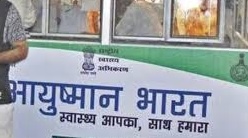New Delhi, Feb 14 (IANS) Ayushman Bharat, India’s flagship healthcare initiative, is significantly advancing the provision of healthcare services and empowering people living in rural India, said experts on Wednesday.
Launched in 2018, this initiative encompasses two primary components: The establishment of Health and Wellness Centers (HWCs) and the implementation of the Pradhan Mantri Jan Arogya Yojana (PM-JAY) — a scheme that extends health insurance coverage for secondary and tertiary care hospitalisation.
The HWCs ensure preventive and curative services with standardised quality at the lowest possible level, that is, sub-centre. It also ensures strengthening of sub-centres with manpower and supplies.
PM-JAY, which provides insurance of Rs 5 lakh to people for health services, ensures equity-based reduction of Out Of Pocket expenditure of people. “These two initiatives are bringing people out of ill health and poverty trap cycle. However there is a need to augment speed of implementation by district and state administrations,” Dr. Harshal R Salve, Additional Professor, Centre for Community Medicine at AIIMS, New Delhi, told IANS.
The HWCs are designed to address the escalating burden of non-communicable diseases by delivering comprehensive primary, secondary, and tertiary healthcare services.
This is particularly imperative in rural regions, where the accessibility of quality healthcare has historically been a formidable challenge.
“One of the biggest problems in the hinterlands for health care is affordability. Ayushman Bharat has empowered citizens who have started seeking health benefits at a very early stage and the fear of getting bankrupt because of expensive health care is no longer there,” Dr Rahul Bhargava, Principal Director of Hematology and Bone Marrow Transplant, Fortis Memorial Research Institute, Gurugram, told IANS.
On Monday, the Union Health Minister Dr Mansukh Mandaviya at an event lauded the achievements of the Ayushman Bharat PM-JAY and Ayushman Arogya Mandir scheme, which he said has not only saved the lives of crores of people but has also kept them from falling below the poverty line.
“By providing family health insurance of Rs 5 lakh annually to 60 crore people of the country, free treatment for serious diseases has been provided. Under this scheme, today even the poor get their treatment in those hospitals where earlier only rich people used to get their treatment,” the minister said.
“Till now, more than 6 crore people have received treatment under this scheme, due to which these poor people have saved more than Rs 1,12,500 crore,” he added.
As of May 31, PM-JAY has successfully enlisted more than 28,350 hospitals and healthcare providers, benefitting more than 519 million vulnerable families throughout India.
In addition, the initiative has established over 1.2 million health and wellness centres, strategically positioned to furnish primary healthcare services to individuals residing in remote and rural locales.
The recent interim budget raised Ayushman Bharat insurance scheme allocation by 10 per cent.
In her interim Budget 2024, Union Finance Minister Nirmala Sitharaman set aside ₹7,500 crore for PM-JAY. This is up from ₹6,881 crore as per the revised estimate for 2023-24, and ₹7,200 as per the budgetary estimate for 2023-24.
“This underscores the government’s persistent dedication to enhancing healthcare accessibility for the entirety of the Indian populace. This supplementary funding is anticipated to fortify the implementation of the scheme and extend its outreach, particularly in rural regions,” Dr. Sabine Kapasi, Advisor, Public Health and Healthcare Services Strategist, UN Covid-19 Task Force told IANS.
Moreover, Sitharaman also extended the Ayushman Bharat scheme to Accredited Social Health Activists (ASHA) and Anganwadi workers and helpers.
There are around 20 lakh ASHA and Anganwadi workers in India. “This represents a significant stride toward augmenting its efficacy in rural areas,” Dr Kapasi said.
“ASHA workers play a pivotal role in promoting healthcare awareness and facilitating access to healthcare services at the grassroots level. Their integration into the scheme is poised to ameliorate its outreach and impact, especially in remote rural communities,” she added.
These positive advancements are expected to further amplify the scheme’s reach and effectiveness, particularly within rural communities, the experts noted.

